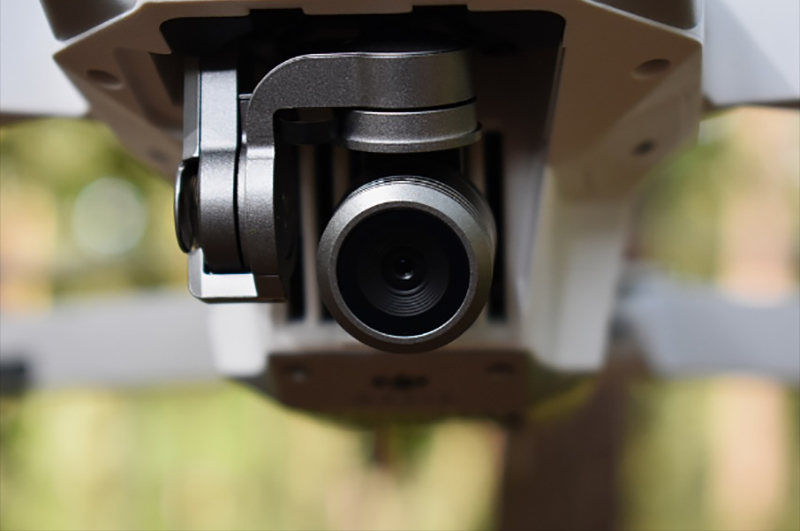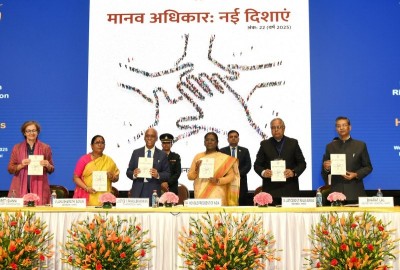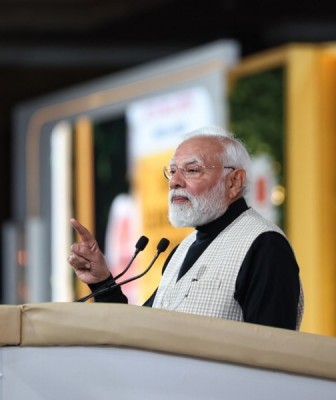 Pakistan
Pakistan
Drone Intrusions
On May 21, 2023, Border Security Force (BSF) shot down a Pakistani drone along the International Border (IB) near Dhanoe Kalan village in Amritsar District of Punjab. In the subsequent search, it recovered a drone along with a consignment of three packets containing three kilograms of narcotics attached to it with an iron ring, from the fields adjacent to the village.
On May 19, 2023, BSF troops shot down two Pakistani drones when they attempted to enter India across the IB in the Amritsar District of Punjab. In the subsequent search, the first drone was recovered from Udhar Dhariwal village, while the second was recovered from Rattan Khurd village. In the second case, two packets attached to the drone, containing 2.6 kilograms of Heroin, were also recovered.
On May 18, 2023, BSF troops recovered 2.1 kilograms of narcotics and a pistol, dropped from a drone, from Bhamba Wattu Hithar village in Fazilka District, Punjab.
On May 17, 2023, BSF troops fired at a drone, coming from Pakistan, in Ramkot village, Amritsar District. Five packets of Heroin were recovered in the subsequent search.
On May 16, 2023 the BSF shot at a Pakistani drone near the IB in Kakkar village, Amritsar District. The BSF recovered 15.5 kilograms of narcotics from the incident site.
According to partial data compiled by Institute for Conflict Management (ICM), at least 57 incidents of drone sightings/entering into India along the India-Pakistan borders/from Pakistan have already been recorded in the current year, 2023 (data till May 21). There were 228 such incidents in 2022, 104 in 2021, 77 in 2020 and 167 in 2019 – a total of 633 incidents since 2019, when the first incident was reported.
As is evident, the highest number of such incidents have been reported from Punjab, followed by J&K, Rajasthan and Gujarat. Punjab accounted for 77.25 per cent of the total incidents from across the four states bordering Pakistan from where such drone crossings have been reported.
Notably, on August 13, 2019, a Pakistani 'Hexacopter Drone' designed and manufactured by T. Motors, a Chinese company, with a 21-kilogram payload capacity, was recovered for the first time, in Mohawa village, Amritsar District.
As SAIR has highlighted earlier, with increasing vigilance along the International Border, Pakistan started using these drones to send ‘composite consignments’ [weapons+drugs+Fake Indian Currency Notes (FICN)] into India. The consignments included drugs such as heroin, opium, etc.; and weapons and ammunition, including AK-47/56 rifles, pistols, and RDX. The Inter-Services Intelligence (ISI) uses the services of a common network of drug smugglers/couriers to push in composite consignments mainly into Indian Punjab from Pakistan, exploiting gaps along the land and riverine borders. The drug smugglers/couriers working under the ISI’s aegis also throw consignments over the border fence in areas where infiltration is not suspected. Their Indian partners later collect the goods. Khalistani groups in Pakistan and their sympathisers and affiliates on the Indian side are intimately connected with the drug/weapons smuggling activity.
On March 27, 2023, Union Minister of State (MoS) for Home Nisith Pramanik informed the Lok Sabha (Lower house of the Parliament),
Anti-national elements/smugglers are using drones for smuggling of Arms/Narcotics across India-Pakistan border in Punjab State. In last three years till 28th Feb 2023, 28 incidents of recovery of drones involved in smuggling of Arms/Narcotics have been detected. From these drones, 125.174 Kgs Heroin, 0.100 Kgs Opium, 9 mm Pistol-01 No., Pistol/Revolver-07 Nos, Magazines-14 Nos, Ammunition 132 Rds, Detonator- 06 Nos and other explosives 4.750 Kgs were recovered.
On April 12, 2023, Ruchira Kamboj, India's Permanent Ambassador to the United Nations (UN), called for international condemnation of Pakistan sending weapons across the IB to terrorists operating in India. Kamboj stated at the Security Council,
We are facing a serious challenge of cross-border supply of illicit weapons using drones, which cannot be possible without active support from the authorities in control of those territories.
The majority of these incidents have involved Chinese hexacopters (one of China’s tactical drones with six blades), which have a payload of up to 80 kilograms, and were likely intended for use in attacks within India.
In the first-ever successful offensive use of drones in India, in the night of June 26-27, 2021, two explosive payloads were dropped, within a span of six minutes, on the Indian Air Force (IAF) station in Jammu, in the Union Territory of Jammu and Kashmir (J&K), by drones/unmanned aerial vehicles (UAVs). Two Security Forces (SF) personnel were injured and a building was damaged in the explosions. Again, in the night of June 27-28, 2021, two drones were found hovering over Ratnuchak and Kaluchak military stations in Jammu. Defence spokesperson Lt. Col. Devender Anand disclosed that “two separate drone activities were spotted over Ratnuchak-Kaluchak military areas” and “a major threat was thwarted by the alertness and proactive approach of troops” who “engaged them [drones] with firing”.
With their ability to quickly and discreetly transport composite consignments while minimizing the risk of detection, drones have become increasingly popular as "ideal drug mules" for Pakistan. India, with its strategic location and porous borders, has become an attractive transit point for drug trafficking from Afghanistan and Pakistan to other parts of the world, including Europe and the United States. Punjab, in particular, has emerged as a prominent target of the illicit drug trade due to its increasing domestic market for drugs.
The use of intelligence inputs and Global Positioning System (GPS) mapping has shown that a significant proportion of incoming drones are controlled from locations such as the Pakistan Rangers' premises or specialized locations utilized by smugglers and terrorists, in close proximity to the rangers' posts.
Meanwhile, in October 2019, India’s Directorate General of Civil Aviation (DGCA) came up with the National Counter Rogue Drone Guidelines, to handle the threat of Unmanned Aircraft Systems (UAV). It recommended a range of measures to combat rogue drones based on the criticality of the assets being safeguarded. The guidelines prescribed the use of primary and passive detection mechanisms, such as radar, Radio Frequency (RF) detectors, electro-optical and infrared cameras, along with soft and hard kill measures like RF jammers, GPS spoofers, lasers, and drone-catching nets.
However, a search for adequate mechanisms to deal with this menace is still going on. Since 2021, the BSF has been conducting a trial of anti-drone technology, which, according to its officials, operates within a specific frequency range and has not yielded satisfactory results in terms of effectiveness. An unnamed senior BSF official thus stated,
Most of the drones being used by Pakistani smugglers are assembled. They are not using drones made by companies, which have fixed frequencies. The possibility of these assembled drones, which fly at varying frequencies, being detected in our anti-drone technology is very less. We need an effective anti-drone technology to tackle the threat.
It is imperative now to make further and rapid technological advancements in the field of anti-drone mechanisms. This is especially crucial in the light of the increasing occurrences of drone incursions.
Support Our Journalism
We cannot do without you.. your contribution supports unbiased journalism
IBNS is not driven by any ism- not wokeism, not racism, not skewed secularism, not hyper right-wing or left liberal ideals, nor by any hardline religious beliefs or hyper nationalism. We want to serve you good old objective news, as they are. We do not judge or preach. We let people decide for themselves. We only try to present factual and well-sourced news.







